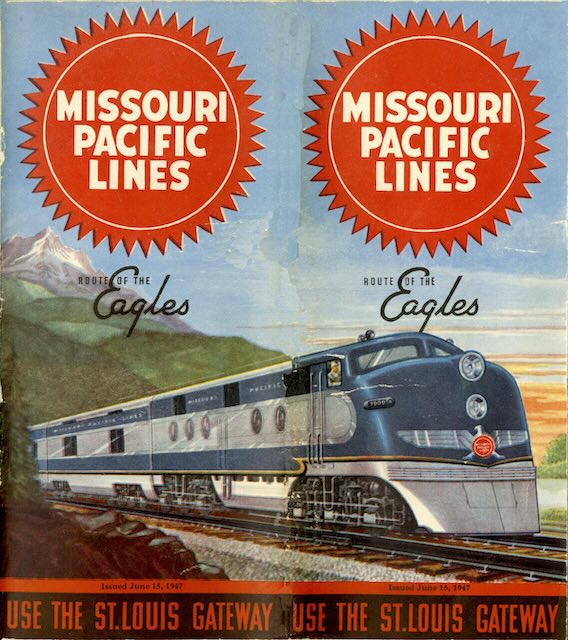Since I last posted Missouri Pacific timetables in February, I’ve acquired several more that I’ll be presenting here over the next week. I estimate that the railroad issued about 45 timetables with this four-color cover, though it is hard to be sure as in some years it issued four timetables and in others only two or three. The last seven timetables, when it issued only two a year, had fewer pages and fewer features than the 38 earlier ones that included many entertaining magazine-style features.
 Click image to download an 28.5-MB PDF of this 48-page timetable.
Click image to download an 28.5-MB PDF of this 48-page timetable.
In 1947, the magazine format was in full bloom. The page before the centerfold map was an article about Memphis accompanied by a color photo. The page after the map was an article about Kansas City with another color photo. The inside back cover was an article about Houston also with a color photo.
The timetable also included many half-page entertaining features. Almost half the space of pages 8 through 19 consisted of articles such as one making the unlikely claim that the San Isabel National Forest contains the “longest single mountain range in the world.” Other articles featured Baton Rouge, Colorado Springs, Salt Lake City, Independence Missouri, and Salina Kansas. There was also a quiz and an article on the origins of the names of several towns in the timetable.
In all, nearly a quarter of the space in the timetable consisted of such entertaining features. A few of these were clearly self-serving, such as an article arguing that rail profits were low at just 3 percent return on investments. But most were aimed to entertain, educate, and inspire people to travel to various locations, which travel the railroad hoped would take place on Missouri Pacific trains.
Less than 10 percent of the timetable consisted of ads for Missouri Pacific services such as the Sunshine Special or Missouri Pacific buses. This included a beautiful back-cover ad that included what appear to be a half-dozen heavily retouched color photos of people enjoying the Gulf Coast, Rio Grande Valley, Colorado mountains, and other destinations.
That left about 67 percent for actual schedules and other standard timetable features such as fares, connections, and a station index. If the railroad had deleted all of the entertaining features and most of the ads, it could have fit everything else into just 32 pages.
It could have saved even more money by using lower quality paper and printing only two colors on the covers and only one on the centerfold map, which is what virtually all other railroads were doing. Compared with, say, the Burlington, which in 1947 printed almost no ads in its timetables and certainly no entertaining features, Missouri Pacific probably spent almost twice as much printing its timetables in the late 1940s and early 1950s.
